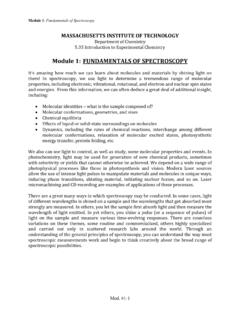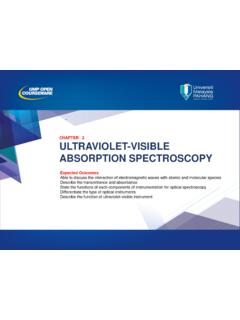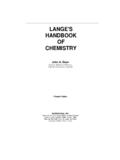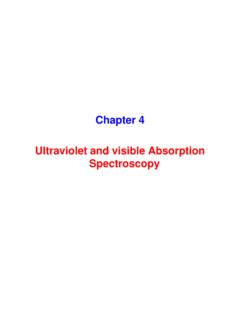Transcription of Spectroscopy: Principles, Theory, Techniques and Applications
1 PDF generated using the open source mwlib toolkit. See for more generated at: Sat, 30 May 2009 17:33:36 UTCS pectroscopy: Principles, Theory, Techniques andApplicationsSpectroscopy2 spectroscopy -An IntroductionSpectroscopyAnimation of the dispersion of light as it travels through atriangular prismSpectroscopy was originally thestudy of the interaction betweenradiation and matter as a functionof wavelength ( ). In fact,historically [1], spectroscopyreferred to the use of visible lightdispersed according to itswavelength, by a prism. Laterthe concept was expanded greatlyto comprise any measurement of aquantity as function of eitherwavelength or frequency. Thus italso can refer to a response to analternating field or varyingfrequency ( ).
2 A further extensionof the scope of the definition added energy (E) as a variable, once the very closerelationship E = h for photons was realized (h is the Planck constant). A plot of theresponse as a function of wavelength or more commonly frequency is referred to as aspectrum; see also spectral is the spectroscopic technique used to assess the concentration or amountof a given species. In those cases, the instrument that performs such measurements is aspectrometer or is often used in physical and analytical chemistry for theidentification of substances through the spectrum emitted from or absorbed by is also heavily used in astronomy and remote sensing. Mostlarge telescopes have spectrometers, which are used either to measure the chemicalcomposition and physical properties of astronomical objects or to measure their velocitiesfrom the Doppler shift of their spectral of methodsExtremely high resolution spectrum of the Sun showingthousands of elemental absorption lines (Fraunhofer lines)Nature of excitationmeasuredThe type of spectroscopy dependson the physical quantity , the quantity that ismeasured is an intensity, either ofenergy absorbed or produced.
3 Electromagnetic spectroscopyinvolves interactions of matterwith electromagnetic radiation,such as light. Electron spectroscopyinvolves interactions withelectron beams. Augerspectroscopy involves inducing the Auger effect with an electron beam. In this case themeasurement typically involves the kinetic energy of the electron as variable. Mass spectrometry involves the interaction of charged species with magnetic and/orelectric fields, giving rise to a mass spectrum. The term "mass spectroscopy " isdeprecated, for the technique is primarily a form of measurement, though it doesproduce a spectrum for observation. This spectrum has the mass m as variable, but themeasurement is essentially one of the kinetic energy of the particle. Acoustic spectroscopy involves the frequency of sound.
4 Dielectric spectroscopy involves the frequency of an external electrical field Mechanical spectroscopy involves the frequency of an external mechanical stress, atorsion applied to a piece of processMost spectroscopic methods are differentiated as either atomic or molecular based onwhether or not they apply to atoms or molecules. Along with that distinction, they can beclassified on the nature of their interaction: Absorption spectroscopy uses the range of the electromagnetic spectra in which asubstance absorbs. This includes atomic absorption spectroscopy and variousmolecular Techniques , such as infrared spectroscopy in that region and nuclear magneticresonance (NMR) spectroscopy in the radio region. Emission spectroscopy uses the range of electromagnetic spectra in which a substanceradiates (emits).
5 The substance first must absorb energy. This energy can be from avariety of sources, which determines the name of the subsequent emission, likeluminescence. Molecular luminescence Techniques include spectrofluorimetry. Scattering spectroscopy measures the amount of light that a substance scatters atcertain wavelengths, incident angles, and polarization angles. The scattering process ismuch faster than the absorption/emission process. One of the most useful Applications oflight scattering spectroscopy is Raman typesAbsorptionAbsorption spectroscopy is a technique in which the power of a beam of light measuredbefore and after interaction with a sample is compared. When performed with tunablediode laser, it is often referred to as Tunable diode laser absorption spectroscopy (TDLAS).
6 It is also often combined with a modulation technique, most often wavelength modulationspectrometry (WMS) and occasionally frequency modulation spectrometry (FMS) in orderto reduce the noise in the of light from a fluorescent lamp showing prominentmercury peaksFluorescence spectroscopy useshigher energy photons to excite asample, which will then emit lowerenergy photons. This techniquehas become popular for itsbiochemical and medicalapplications, and can be used forconfocal microscopy, fluorescenceresonance energy transfer, andfluorescence lifetime rayWhen X-rays of sufficientfrequency (energy) interact with asubstance, inner shell electrons in the atom are excited to outer empty orbitals, or they maybe removed completely, ionizing the atom.
7 The inner shell "hole" will then be filled byelectrons from outer orbitals. The energy available in this de-excitation process is emittedas radiation (fluorescence) or will remove other less-bound electrons from the atom (Augereffect). The absorption or emission frequencies (energies) are characteristic of the specificatom. In addition, for a specific atom small frequency (energy) variations occur which arecharacteristic of the chemical bonding. With a suitable apparatus, these characteristicX-ray frequencies or Auger electron energies can be measured. X-ray absorption andemission spectroscopy is used in chemistry and material sciences to determine elementalcomposition and chemical crystallography is a scattering process; crystalline materials scatter X-rays atwell-defined angles.
8 If the wavelength of the incident X-rays is known, this allowscalculation of the distances between planes of atoms within the crystal. The intensities ofthe scattered X-rays give information about the atomic positions and allow the arrangementof the atoms within the crystal structure to be calculated. Spectroscopy5 FlameLiquid solution samples are aspirated into a burner or nebulizer/burner combination,desolvated, atomized, and sometimes excited to a higher energy electronic state. The use ofa flame during analysis requires fuel and oxidant, typically in the form of gases. Commonfuel gases used are acetylene (ethyne) or hydrogen. Common oxidant gases used areoxygen, air, or nitrous oxide. These methods are often capable of analyzing metallicelement analytes in the part per million, billion, or possibly lower concentration detectors are needed to detect light with the analysis information coming from theflame.
9 Atomic Emission spectroscopy - This method uses flame excitation; atoms are excitedfrom the heat of the flame to emit light. This method commonly uses a total consumptionburner with a round burning outlet. A higher temperature flame than atomic absorptionspectroscopy (AA) is typically used to produce excitation of analyte atoms. Since analyteatoms are excited by the heat of the flame, no special elemental lamps to shine into theflame are needed. A high resolution polychromator can be used to produce an emissionintensity vs. wavelength spectrum over a range of wavelengths showing multiple elementexcitation lines, meaning multiple elements can be detected in one run. Alternatively, amonochromator can be set at one wavelength to concentrate on analysis of a singleelement at a certain emission line.
10 Plasma emission spectroscopy is a more modernversion of this method. See Flame emission spectroscopy for more details. Atomic absorption spectroscopy (often called AA) - This method commonly uses apre-burner nebulizer (or nebulizing chamber) to create a sample mist and a slot-shapedburner which gives a longer pathlength flame. The temperature of the flame is lowenough that the flame itself does not excite sample atoms from their ground state. Thenebulizer and flame are used to desolvate and atomize the sample, but the excitation ofthe analyte atoms is done by the use of lamps shining through the flame at variouswavelengths for each type of analyte. In AA, the amount of light absorbed after goingthrough the flame determines the amount of analyte in the sample.








